
- Home
- Travel Packages
- Top Destination
-
Travel Attraction
By Category
Top Attraction

- Travel Agents
- Car Rentals
- Hotels
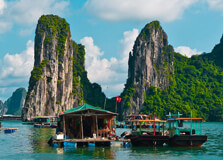
Hạ Long Bay, located in Quảng Ninh Province, Vietnam, is a spectacular UNESCO World Heritage Site recognized for its thousands of limestone karsts and islets rising dramatically from the emerald green waters. Covering around 1,553 km² and featuring about 1,969 islets (775 in the core area), the bay narrates a geological history dating back 500 million years and a rich human past spanning 18,000 years :contentReference[oaicite:1]{index=1}. How to Reach Hạ Long Bay, Ha Long Situated approximately 170 km northeast of Hanoi, the bay is well connected: By road: Buses and private cars make the 3–4 hour trip from Hanoi; luxury shuttle buses are also available :contentReference[oaicite:2]{index=2}. By sea or air: Helicopter and seaplane services cut travel time to ~45 minutes and include aerial views :contentReference[oaicite:3]{index=3}. Local boat transfers: Depart from Ha Long City or Tuan Chau Island for day or overnight cruises into the bay :contentReference[oaicite:4]{index=4}. Weather The bay enjoys a subtropical climate: Spring (Mar–May) & Autumn (Sep–Nov): Best visiting months – mild (18–30°C), dry, clear skies :contentReference[oaicite:5]{index=5}. Summer (Jun–Aug): Hot (25–35°C), humid, with occasional storms – ideal for swimming but heavy with tourists :contentReference[oaicite:6]{index=6}. Winter (Dec–Feb): Cooler (15–25°C), misty mornings – beautiful and quiet, though not suitable for swimming :contentReference[oaicite:7]{index=7}. Timing The bay can be visited year-round. However, timing your visit ensures the best experience: Peak season: Late spring and autumn offer ideal weather and fewer crowds :contentReference[oaicite:8]{index=8}. Best times of day: Daybreak and dusk offer sublime light and quieter waters :contentReference[oaicite:9]{index=9}. Festival season: Visit during late April to early May for the vibrant Hạ Long Carnival :contentReference[oaicite:10]{index=10}. Why Famous for Hạ Long Bay, Ha Long? Hạ Long Bay is world-famous due to: Natural grandeur: A dramatic seascape of thousands of limestone towers sculpted by millions of years of erosion :contentReference[oaicite:11]{index=11}. UNESCO status: Listed in 1994 and expanded in 2000 for its universal aesthetic and geological importance :contentReference[oaicite:12]{index=12}. Myth and legend: The name “Descending Dragon” evokes local folklore where dragons created the islands to defend the coast :contentReference[oaicite:13]{index=13}. Cultural charm: Floating villages, pearl farms, and seafood delicacies like cha muc and ngán wine :contentReference[oaicite:14]{index=14}. Filmic appeal: Featured in films such as “Kong: Skull Island” and “Tomorrow Never Dies” :contentReference[oaicite:15]{index=15}. Entry and Visit Details about Hạ Long Bay, Ha Long No general park fee; cruise packages vary with duration and amenities. Entry to caves and islands (e.g. Ti Tốp, Sung Sot) are included in cruise tickets or cost $2–5 extra :contentReference[oaicite:16]{index=16}. Choose licensed tours; safety regulations are enforced but check ratings :contentReference[oaicite:17]{index=17}. History & "Architecture" (Karst Geology) Formed over 500 million years, the bay’s karst towers reflect a complex geological history of tectonics, erosion, and sea level changes :contentReference[oaicite:18]{index=18}. First human traces date back 18,000 years with Soi Nhụ and Hạ Long cultures. The bay later became a strategic naval defense site during the 13th-century Trần Dynasty, including the famous Battle of Bạch Đằng :contentReference[oaicite:19]{index=19}. Things to Do Cruise: Overnight or day junk-style cruises; modern options exist :contentReference[oaicite:20]{index=20}. Kayaking & swimming: Paddle among karsts or swim in secluded coves :contentReference[oaicite:21]{index=21}. Cave visits: Explore Sung Sot, Thien Cung, Hang Dau Go (Wooden Stakes) :contentReference[oaicite:22]{index=22}. Visit floating villages: Cửa Vạn, Vung Viêng for cultural insight & pearl farms :contentReference[oaicite:23]{index=23}. Beach stops: Ti Tốp, Cat Ba, Tuan Chau for beach time and hiking :contentReference[oaicite:24]{index=24}. Adventure sports: Rock climbing, deep-water soloing on Butterfly Island :contentReference[oaicite:25]{index=25}. Festivals: Enjoy live performances during the Hạ Long Carnival in April/May :contentReference[oaicite:26]{index=26}. Facts about Hạ Long Bay, Ha Long ~1,969 islets over ~1,553 km²; deepest depth ~10 m :contentReference[oaicite:27]{index=27}. Home to ~1,600 residents in four floating villages; abundant biodiversity incl. 450 mollusc & 200+ fish species :contentReference[oaicite:28]{index=28}. Formed over 500 million years; contains fenglin tower karst shapes :contentReference[oaicite:29]{index=29}. UNESCO site (1994/2000), New7Wonders (2011), part of “Most Beautiful Bays” club :contentReference[oaicite:30]{index=30}. Featured in major films and hosts annual carnivals :contentReference[oaicite:31]{index=31}. Tips for Visiting Hạ Long Bay, Ha Long Pick cruise wisely: Small boats = fewer crowds; include activities like kayaking, cave visits :contentReference[oaicite:32]{index=32}. Best seasons: Spring/autumn for mild weather and clear skies; early winter for misty beauty :contentReference[oaicite:33]{index=33}. Avoid crowds: Travel weekdays or choose Bai Tu Long/Lan Ha Bay routes :contentReference[oaicite:34]{index=34}. Essentials: Bring swimwear, sunscreen, insect repellent, hat, light rain gear :contentReference[oaicite:35]{index=35}. Respect local life: Ask before photographing floating villagers, avoid littering, support local crafts :contentReference[oaicite:36]{index=36}. Safety first: Use life-jackets, check weather, ensure travel insurance :contentReference[oaicite:37]{index=37}. Capture the moment: Early morning or dusk light is magical for photography :contentReference[oaicite:38]{index=38}. Conclusion Hạ Long Bay is much more than a scenic marvel—it’s a timeless landscape blending natural wonder, cultural heritage, and adventurous exploration. Whether you embark on a junk boat cruise, kayak through misty karsts, explore ancient caves, meet floating-fisher communities, or celebrate at the bay’s vibrant festivals, this legendary seascape promises a profoundly memorable and magical experience.
Explore More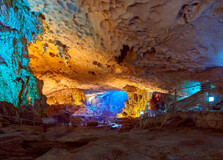
Sung Sot Cave, literally "Surprise Cave", is the largest and most spectacular cave in Hạ Long Bay, located on Bồ Hòn Island. Discovered by the French in 1901 and opened to tourists in 1993, it boasts vast chambers adorned with thousands of stalactites and stalagmites that resemble mythical figures and natural sculptures :contentReference[oaicite:0]{index=0}. How to Reach Sung Sot Cave, Ha Long Sung Sot is accessible exclusively by boat via Halong Bay's Route 2 tours. Depart from Tuan Chau or Hạ Long International Passenger Port: Daily day-boat tours (typically 6–8 hr) include Sung Sot, Ti Tốp Island, and other attractions :contentReference[oaicite:1]{index=1}. Day-boat fare: ~200,000 VND per person for boat transport :contentReference[oaicite:2]{index=2}. Overnight cruises: Include cave visits plus accommodation and meals, costing US$100–200 :contentReference[oaicite:3]{index=3}. Private canoe: For quick visits or smaller groups; ~50 USD per hour :contentReference[oaicite:4]{index=4}. By road: From Hanoi, spend 3–4 hr via luxury bus or private car to reach ports :contentReference[oaicite:5]{index=5}. Weather The cave is best visited during cooler, drier seasons: October–April: Mild climate with low humidity and fewer tourists :contentReference[oaicite:6]{index=6}. May–July: Warm with occasional rain, suitable for exploration :contentReference[oaicite:7]{index=7}. Winter (Dec–Feb): Cooler, misty mornings enhance the mystical atmosphere, but cave floors remain wet :contentReference[oaicite:8]{index=8}. Timing Opening hours: Daily 08:00–17:00 :contentReference[oaicite:9]{index=9}. Tours generally depart between 06:30–08:00 or midday :contentReference[oaicite:10]{index=10}. Best times to visit: Mornings are less crowded; weekdays are preferable :contentReference[oaicite:11]{index=11}. Why Famous for Sung Sot Cave, Ha Long? Massive size: Over 12,000 m² with two cathedral-like chambers up to 30 m high :contentReference[oaicite:12]{index=12}. Iconic formations: Rock formations resemble mythical creatures and even incorporate legend of Saint Giong’s horse hoofprints and sword :contentReference[oaicite:13]{index=13}. The element of surprise: A small entrance opens into enormous chambers, hence its name :contentReference[oaicite:14]{index=14}. Historical allure: Named “Grotte de la Surprise” by French explorers; became a popular tourist site since 1993 :contentReference[oaicite:15]{index=15}. Entry and Visit Details about Sung Sot Cave, Ha Long Cave entrance fees: 100,000–150,000 VND when purchased separately; otherwise included in Route 2 tour pricing (~290,000 VND) :contentReference[oaicite:16]{index=16}. Boat/canoe fees: 200,000 VND for shared boat rides; private canoe ~50 USD/hr :contentReference[oaicite:17]{index=17}. Stairs access: ~100 steps up to entrance and another ~80 inside—wear sturdy, non-slip shoes :contentReference[oaicite:18]{index=18}. Facilities: Lighting, handrails, paths; small refreshment stalls near entrance :contentReference[oaicite:19]{index=19}. History & Natural “Architecture” Sung Sot’s limestone architecture formed over millions of years. The French discovered it in 1901 and dubbed it “Grotte de la Surprise.” It remained largely unknown until opening in 1993 :contentReference[oaicite:20]{index=20}. The cave features a structure of two main chambers: the first “Waiting Room” with expansive stalactites; the second “Serene Castle” houses lily-like formations, freshwater ponds, and even occasionally monkeys :contentReference[oaicite:21]{index=21}. Things to Do Join a day or overnight cruise that includes cave explorations and island stops :contentReference[oaicite:22]{index=22}. Climb the rugged stairway into the cave for fresh-air and anticipation. Explore both cave chambers—pause to admire formations and take photographs. Join guided tours to learn geological and mythological details. Enjoy swimming, kayaking, or paddle-boat rides from cruise decks between stops :contentReference[oaicite:23]{index=23}. Sample seafood at floating villages or on cruise dining decks :contentReference[oaicite:24]{index=24}. Facts about Sung Sot Cave, Ha Long Area: ~12,000 m²; chambers 30 m high :contentReference[oaicite:25]{index=25}. About 14 km from Bãi Cháy Wharf; sits on Bồ Hòn Island :contentReference[oaicite:26]{index=26}. Opened to tourists in 1993, though discovered in 1901 :contentReference[oaicite:27]{index=27}. Legend connects it to Champa hero Thanh Giong :contentReference[oaicite:28]{index=28}. Entrance climb: ~180 steps total :contentReference[oaicite:29]{index=29}. Tips for Visiting Sung Sot Cave, Ha Long Footwear: Wear sturdy, non-slip shoes—cave floors remain wet :contentReference[oaicite:30]{index=30}. Best season: Visit between October–April; cooler months offer comfort and fewer crowds :contentReference[oaicite:31]{index=31}. Timing: Morning departures are less crowded; weekdays are quieter :contentReference[oaicite:32]{index=32}. Bring essentials: Water, insect repellent, light jacket, flashlight optional :contentReference[oaicite:33]{index=33}. Photography: Flash is allowed; won’t damage formations but may be bright :contentReference[oaicite:34]{index=34}. Watch your step: Steps and marble-look floors can be slippery :contentReference[oaicite:35]{index=35}. Combine tours: Include Ti Tốp, Luồn cave, or floating village to maximize experience :contentReference[oaicite:36]{index=36}. Respect environment: Avoid littering and support eco-conscious cruise operators :contentReference[oaicite:37]{index=37}. Conclusion Sung Sot Cave stands as Ha Long Bay’s crown jewel—a geological wonder blending awe-inspiring chambers, mythic legends, and dramatic architecture of stone. A visit provides not just visual spectacle but also a sense of entering a secret, magical realm. Whether on a day cruise or overnight journey, the stair climb, the grandeur of the chambers, the folklore, and the surrounding bay create a deeply memorable experience that captures the imagination and spirit of Vietnam’s natural heritage.
Explore More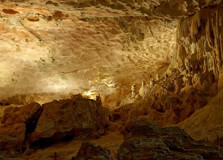
Dau Go Cave, also known as Wooden Stakes Cave, is one of the most famous and breathtaking caves in Ha Long Bay, Vietnam. Situated on Dau Go Island, the cave is a magnificent natural wonder renowned for its impressive limestone formations, enormous caverns, and rich historical significance. Visitors to Ha Long Bay often include Dau Go Cave in their itinerary to experience its awe-inspiring stalactites and stalagmites, as well as to learn about the legendary stories connected to it. How to Reach Dau Go Cave, Ha Long Dau Go Cave is located within Ha Long Bay, so the primary way to reach it is by boat or cruise. Most visitors book a day cruise or an overnight cruise that includes stops at key attractions around Ha Long Bay, with Dau Go Cave being a highlight. The cave lies on Dau Go Island, which is accessible only by water. From Ha Long City, boat tours depart daily from Bai Chay Marina or Tuan Chau Island Harbor. The journey by boat to Dau Go Cave typically takes 30 to 60 minutes depending on the route. Some cruises combine visits to other attractions like Sung Sot Cave, Titov Island, and floating fishing villages. Weather The best time to visit Dau Go Cave and Ha Long Bay is during the dry season, from October to April, when the weather is cooler and rainfall is limited. This period offers the clearest skies and calm waters, ideal for cruising and exploring caves. October to April: Mild temperatures ranging from 15°C to 25°C (59°F to 77°F), perfect for outdoor activities and sightseeing. May to September: Hot, humid, and rainy, with occasional storms that can affect boat tours and cave visits. Timing Dau Go Cave is generally open to visitors from 7:30 AM until around 5:00 PM, aligning with the operating hours of most cruises and tourist boats. It’s recommended to visit in the morning or early afternoon to avoid crowds and to enjoy better lighting inside the cave. Why Famous for Dau Go Cave, Ha Long? Dau Go Cave is famous for both its natural beauty and historical significance. The cave’s name, meaning "Wooden Stakes Cave," is tied to a legendary event during the 13th century when Vietnamese general Tran Hung Dao is said to have hidden wooden stakes in the cave to defeat invading Mongol fleets. This fascinating story enriches the cultural value of the cave beyond its geological wonders. The cave itself is enormous, with multiple chambers filled with extraordinary limestone formations. Visitors can admire towering stalactites, stalagmites, and rock pillars that have been sculpted over millions of years, creating a magical and mysterious atmosphere. The cave’s size and intricate shapes make it one of the largest and most spectacular caves in Ha Long Bay. Entry and Visit Details about Dau Go Cave, Ha Long Access to Dau Go Cave is included in many Ha Long Bay cruise packages, but if visiting independently, you need to purchase an entrance ticket at the cave entrance. The ticket prices are generally affordable: Adult ticket: Approximately 40,000 to 50,000 VND (about $2 to $2.50 USD) Children and students: Discounted rates are often available. Once inside, visitors follow well-maintained wooden walkways and stairs to explore the cave’s chambers. Guided tours are available on some cruises or at the cave to explain the geological formations and share the historical background. History and Architecture Dau Go Cave is steeped in history and mythology. According to legend, during the Mongol invasions in the 13th century, General Tran Hung Dao ordered wooden stakes to be hidden inside the cave to thwart the enemy’s ships in the bay, resulting in a decisive Vietnamese victory. This historic event gave the cave its name and made it a symbol of national pride and resistance. Architecturally, the cave is a masterpiece of natural design. Its multiple chambers vary in size, with the largest chamber measuring around 30 meters high and 40 meters wide. The interior is filled with a vast array of limestone stalactites and stalagmites in all shapes and sizes, many of which have been named by locals for their resemblance to animals, objects, or mythical figures. These natural sculptures create an awe-inspiring environment that feels almost like a natural cathedral. Things to Do at Dau Go Cave Explore the cave chambers: Walk along the wooden pathways and admire the spectacular formations inside the cave. Photography: Capture stunning shots of the intricate limestone shapes and the cave’s vast interior. Learn about history: Listen to stories about General Tran Hung Dao and the role of the cave in Vietnamese history. Combine with other attractions: Many tours include stops at nearby Sung Sot Cave, Titov Island, or floating villages, allowing for a full-day adventure in Ha Long Bay. Facts about Dau Go Cave, Ha Long Dau Go Cave is one of the largest and oldest caves in Ha Long Bay. The cave is approximately 90 meters long and has several large chambers. The name “Dau Go” means “Wooden Stakes,” referring to the historic event involving the Mongol invasion. The cave’s formations took millions of years to develop through natural erosion and mineral deposits. Dau Go Cave is part of the UNESCO World Heritage-listed Ha Long Bay. Tips about Visiting Dau Go Cave, Ha Long Wear comfortable walking shoes, as there are stairs and slippery surfaces inside the cave. Bring a light jacket or sweater as the cave interior can be cooler than outside. Visit early in the day to avoid crowds and enjoy better lighting for photos. Hire a local guide or join a guided tour to get detailed historical and geological information. Be mindful of slippery surfaces and watch your step while exploring. Combine your visit with other nearby attractions to maximize your Ha Long Bay experience. Conclusion Dau Go Cave is a must-visit destination in Ha Long Bay for nature lovers, history enthusiasts, and photographers alike. Its impressive size, intricate limestone formations, and rich cultural background offer a unique blend of natural wonder and historical intrigue. Whether you are on a day cruise or an extended stay in Ha Long Bay, spending time exploring Dau Go Cave will provide unforgettable memories and a deeper appreciation of Vietnam’s natural and cultural heritage.
Explore More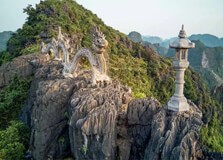
Mua Caves (Hang Múa), located in Ninh Binh Province, is one of Vietnam’s most famous and photogenic destinations. The site is well known for its panoramic views of the surrounding Tam Coc landscape and rice fields from the top of a limestone mountain. The area gets its name from the cave located at the base, but the real draw is the dramatic staircase of over 500 steps leading to the summit, where a giant stone dragon sculpture awaits visitors at the peak. Mua Caves offers a combination of cultural, spiritual, and natural experiences. Whether you are an avid photographer, a hiker, or simply looking for breathtaking scenery, Mua Caves is an essential stop during any visit to Ninh Binh. How to Reach Mua Caves, Ninh Binh Mua Caves is located around 6 kilometers from Ninh Binh city center and just 4 kilometers from Tam Coc. It is easily accessible by bicycle, motorbike, or taxi. - From Hanoi: The journey takes approximately 2 hours (about 100 km). You can travel by train, bus, or private car to Ninh Binh, then continue by taxi or bike to Mua Caves. - By Train: Take a train from Hanoi to Ninh Binh station, then a short drive to the caves. - By Bus: Many bus operators run trips from Hanoi’s Giap Bat or My Dinh bus station to Ninh Binh daily. - By Motorbike: For adventurous travelers, renting a motorbike in Hanoi and driving down offers flexibility and scenic countryside views. Weather in Mua Caves, Ninh Binh The best time to visit Mua Caves is during the dry season, from November to April, when temperatures are pleasant and skies are clearer, making it ideal for hiking and photography. - Dry Season (Nov - Apr): Cool and sunny, with average temperatures between 18°C and 27°C (64°F to 80°F). - Wet Season (May - Oct): Hot and humid, with sudden rain showers. The landscape is lush green during this time, especially scenic during the rice harvest season in late May to early June. Timing of Mua Caves Mua Caves is open daily from 6:00 AM to 7:00 PM. Early mornings are highly recommended, not just to avoid the heat but also to enjoy the sunrise view over Tam Coc and the rice fields. Sunset is another magical time to visit, though it may be more crowded. Allow around 1.5 to 2 hours for climbing and exploring. Why Famous for Mua Caves, Ninh Binh? Mua Caves is famous for its panoramic viewpoints and iconic dragon sculpture that guards the summit. The 500-step stone staircase zigzags up the mountain, offering stunning views of the Ngo Dong River, rice fields, and limestone peaks below. This climb is considered the highlight of any trip to Ninh Binh. The site is often called the "Great Wall of Vietnam" due to its winding path and mountain-top views. It is a must-visit for photographers, influencers, and nature lovers seeking dramatic scenery. Entry and Visit Details about Mua Caves, Ninh Binh - Entry Fee: 100,000 VND per person (subject to change) - Opening Hours: 6:00 AM to 7:00 PM - Parking: Available for motorbikes and bicycles near the entrance - Facilities: There are restaurants, cafes, rest areas, and bathrooms within the complex. Tickets can be purchased at the entrance, and maps or guides are available for first-time visitors. History and Architecture While the main attraction is the climb and view, Mua Caves also has cultural and spiritual significance. At the base of the mountain lies a cave used historically for royal dances, hence the name "Hang Múa," which means "Dancing Cave." The staircase to the summit is built in a traditional Vietnamese architectural style, with dragon and phoenix carvings along the path. At the top, a large stone dragon reminiscent of the Ly Dynasty architecture stretches protectively along the ridge. A small pagoda also marks the summit, offering a place for quiet contemplation. Things to Do at Mua Caves - Climb to the Summit: The 500-step hike is the main activity, offering 360° views. - Photography: Capture panoramic views, especially during sunrise or sunset. - Explore the Base Cave: Visit the cave area and learn about its cultural history. - Visit the Pagoda: Offer incense or meditate quietly at the mountaintop pagoda. - Relax at Lotus Lake: In summer, blooming lotus flowers create a beautiful foreground for photos. - Enjoy Local Food: Nearby restaurants and cafes offer local Vietnamese dishes. Facts about Mua Caves - The name "Hang Múa" translates to "Dance Cave." - There are exactly 486 stone steps to the top. - The dragon sculpture at the summit symbolizes protection and strength. - It offers one of the best aerial views of Tam Coc and the Ngo Dong River. - The site is part of the larger Mua Eco-Tourism Complex, including gardens and lodges. - Many travelers compare the view to the famous peaks of Guilin, China, and Halong Bay. Tips about Mua Caves, Ninh Binh - Visit Early: Beat the heat and crowds by arriving at sunrise. - Wear Comfortable Shoes: The steps are steep and uneven, so good grip is essential. - Bring Water: Stay hydrated, especially if visiting during warmer months. - Avoid Midday: The sun is harsh and there is little shade on the stairs. - Dress Modestly: If visiting the pagoda, wear clothing that covers shoulders and knees. - Carry a Camera or Drone: For stunning aerial and landscape shots. - Explore Nearby Attractions: Combine your trip with Tam Coc, Trang An, or Bich Dong Pagoda.
Explore More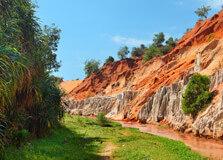
Fairy Stream, known locally as "Suối Tiên," is a unique natural attraction located in the Mui Ne area of Phan Thiet, Vietnam. Despite the name, it is not a stream full of fairies, but rather a shallow, slow-moving creek surrounded by red and white limestone cliffs, lush bamboo groves, and sand formations that look otherworldly. Its dreamy scenery has made it one of the most photographed and visited natural spots in the region. What makes the Fairy Stream special is the combination of soft red sands and clear water, which visitors can walk through barefoot. The landscape changes from tropical forest to canyon-like cliffs as you make your way upstream. It’s peaceful, scenic, and perfect for a relaxed, barefoot adventure, often described as a hidden gem within the bustling Mui Ne tourist area. How to Reach Fairy Stream, Phan Thiet Fairy Stream is located in Mui Ne Ward, around 18 kilometers northeast of Phan Thiet city center. - From Phan Thiet: You can take a taxi, motorbike, or local bus to Mui Ne, which takes about 30–40 minutes. From there, it’s a short ride to the stream entrance. - From Mui Ne Beach: Most hotels and resorts in Mui Ne are within 10–15 minutes of Fairy Stream. You can easily reach it on foot, by bicycle, or by scooter. - As Part of a Tour: Fairy Stream is often included in half-day or full-day jeep tours that also visit the sand dunes and other Mui Ne landmarks. Weather at Fairy Stream The climate in Phan Thiet is tropical and relatively dry, making it a year-round destination. However, the best time to enjoy Fairy Stream is during the dry season. - Dry Season (Nov to Apr): Sunny, dry, and ideal for exploration. Temperatures range from 25°C to 30°C. - Wet Season (May to Oct): Rain can make the stream murky, but it still remains passable. Early mornings are often clear. Timings for Visiting Fairy Stream Fairy Stream is open daily from around 6:00 AM to 6:00 PM. There is no strict opening or closing time since it is a natural attraction, but daytime visits are recommended for safety and visibility. The best times to visit are early in the morning (before 9:00 AM) or late afternoon (after 4:00 PM), when the sun is less intense and the light is ideal for photography. Why Famous for Fairy Stream, Phan Thiet? Fairy Stream is famous for its extraordinary landscape—a narrow, sandy stream that meanders through dramatic rock formations and lush greenery. The contrast between the red sand, white limestone cliffs, and green vegetation is truly picturesque. Visitors love walking barefoot in the warm, shallow water while admiring the scenic views. Additionally, the experience is peaceful and meditative. There are no large crowds or noisy vendors once you enter the stream, just the sounds of trickling water and rustling leaves. Entry and Visit Details about Fairy Stream, Phan Thiet - Entrance Fee: Around 15,000 – 20,000 VND (less than $1 USD) - Guides: Optional; local guides may offer to lead you for an additional tip - Footwear: Most visitors walk barefoot as the sandy streambed is soft and shallow - Duration: It takes about 45 minutes to 1 hour to walk to the end of the stream and back Be sure to enter from the marked entrance near the small bridge on Huynh Thuc Khang Street. Some vendors near the entrance may offer to watch over your shoes or sell refreshments. History and Natural Formation Fairy Stream was formed over centuries by the slow erosion of the area’s soft limestone and red sand. Wind and water carved the unique formations that now line the stream's banks. The colors are due to mineral content in the soil, which ranges from rust red to pale white. Though not linked to any major historical event, the stream holds a mystical appeal. According to local folklore, the name "Fairy Stream" comes from the belief that fairies once bathed in its waters due to its secluded beauty and gentle flow. Things to Do at Fairy Stream Walk Barefoot: Enjoy a leisurely stroll through the stream and feel the soft sand under your feet. Photography: Capture stunning photos of the cliffs, water, and reflections. Visit the Mini Waterfall: At the far end of the stream lies a small waterfall worth the extra walk. Climb the Sand Dunes: Along the walk, you'll find areas where you can climb small sand hills for a better view. Interact with Locals: Occasionally, you may encounter children or locals playing or offering snacks and drinks. Combine with a Tour: Fairy Stream is often paired with trips to Red or White Sand Dunes. Facts about Fairy Stream The stream is only ankle to calf deep, making it safe for kids and non-swimmers. The entire route is about 1.5 kilometers round-trip. It’s one of the few natural attractions in Vietnam that can be explored barefoot in water. Photographers love it for its unusual textures, colors, and patterns in the landscape. Despite being well-known, it remains quiet and uncrowded most of the time. Tips about Fairy Stream, Phan Thiet Visit early or late: The lighting is best and temperatures are cooler. Go barefoot: The streambed is soft and walking in water adds to the experience. Bring a towel and extra sandals: Your feet will be wet and sandy afterward. Protect your electronics: If you're carrying a phone or camera, use a waterproof pouch or bag. Stay hydrated: Bring a bottle of water as there are limited vendors along the way. Wear sun protection: Hats and sunscreen are essential, especially if visiting midday. Be respectful: Avoid littering and respect the peaceful, natural environment.
Explore More
Fansipan Mountain, located in Lao Cai Province in northwestern Vietnam, is the highest peak in Indochina, standing proudly at 3,147.3 meters (10,326 feet) above sea level. Known as the "Roof of Indochina," Fansipan is part of the majestic Hoang Lien Son mountain range and draws adventure seekers, nature lovers, and spiritual travelers alike. This awe-inspiring destination is famous not just for its height but for its breathtaking natural scenery, challenging hiking trails, cultural significance, and modern cable car system that has made the summit accessible to many. How to Reach Fansipan Mountain, Lao Cai Fansipan is located about 9 km southwest of Sapa Town in Lao Cai Province. Travelers typically reach Fansipan via Sapa, which serves as the main base for trips to the mountain. From Hanoi: Take an overnight train or sleeper bus to Lao Cai City (approx. 8 hours), then a shuttle or taxi to Sapa (about 1 hour). From Sapa to Fansipan: The Fansipan Cable Car Station is located in Muong Hoa Valley, about 3 km from Sapa. You can reach it by taxi, shuttle, or even by walking if you enjoy short hikes. Hiking Option: Trekking to the summit takes 1 to 3 days depending on the chosen route and your physical condition. Local tour agencies offer guided treks with porters and meals included. Weather at Fansipan Mountain, Lao Cai Fansipan’s climate varies with altitude and time of year, offering dramatically different experiences: Spring (March to May): Ideal for trekking and sightseeing. Temperatures are moderate (15–25°C) with blooming flowers across the hills. Summer (June to August): Lush green scenery, but expect occasional rain. Temperatures range between 18–28°C. Autumn (September to November): Clear skies, golden rice terraces, and cool air. This is the most popular season for visitors. Winter (December to February): Cold temperatures (can drop below 0°C at the summit) and occasional snow, offering a magical experience for those prepared for the cold. Timings for Visiting Fansipan Mountain Fansipan Cable Car: Operates daily from 7:30 AM to 5:30 PM Trekking Hours: Best to start early in the morning (around 6:00 AM) to make the most of daylight and weather Best Time to Visit: March–May and September–November for ideal weather and visibility Why Famous for Fansipan Mountain, Lao Cai? Fansipan is celebrated for its dramatic altitude, scenic views, biodiversity, and cultural connections: Highest mountain in Vietnam and Indochina Offers stunning panoramas of mountain ranges, valleys, and clouds Home to rich flora and fauna including orchids, rhododendrons, and rare animals Holds spiritual significance with Buddhist temples and statues on the summit Accessible via a world-class cable car system recognized for its engineering Entry and Visit Details about Fansipan Mountain, Lao Cai Entry Fee: No entry fee for the mountain itself; however, cable car tickets must be purchased Cable Car Ticket (Round Trip): Approx. 750,000 VND (subject to change) Funicular (optional): Available for visitors wanting to skip the final steps to the summit (extra cost) Hiking Permit: Required for trekkers; available through tour agencies Tour Guide: Mandatory for most hiking routes due to terrain and safety regulations History and Architecture of Fansipan Mountain Once accessible only to experienced hikers, Fansipan’s appeal grew after the launch of the Fansipan Legend Cable Car in 2016, which drastically reduced the journey to the summit from 2–3 days to just 15–20 minutes. The architectural elements around the summit area blend Buddhist symbolism with traditional Vietnamese design. The summit features: Great Buddha Statue: One of Vietnam’s largest seated bronze Buddha statues, symbolizing enlightenment and peace Bao An Zen Monastery: A beautifully designed temple offering spiritual refuge Stele House and Flagpole: Symbolic structures representing victory and national pride Tram Ton Pass: Known as Heaven’s Gate, it’s the highest mountain pass in Vietnam and serves as a starting point for treks Things to Do at Fansipan Mountain Take the Cable Car: A scenic and thrilling ride offering aerial views of Muong Hoa Valley and Hoang Lien Forest Hike to the Summit: For adventurous visitors, experience the challenge and reward of a multi-day trek Explore the Spiritual Complex: Visit temples, pagodas, and statues at the summit Photography: Capture clouds rolling over the mountains, panoramic landscapes, and spiritual sites Enjoy Local Cuisine: Sample Sapa specialties like grilled meat skewers, corn wine, and sticky rice after your journey Facts about Fansipan Mountain, Lao Cai Fansipan was first successfully climbed by a French expedition in 1905 The cable car system was awarded 2 Guinness World Records for the longest three-rope cable car and greatest vertical ascent The summit is frequently covered in mist or clouds, adding to its mystique Hiking routes range from intermediate to challenging; experienced guides are highly recommended Flora includes over 2,000 plant species, including many medicinal and endemic plants Tips about Fansipan Mountain, Lao Cai Book Tickets in Advance: Especially during weekends and holidays Dress in Layers: Weather at the summit can change quickly Start Early: Morning visits offer the best chance for clear views Stay Hydrated and Bring Snacks: Particularly for hikers Respect Cultural Sites: Be mindful at temples and follow local customs Acclimate to Altitude: Spend a day in Sapa before trekking to avoid altitude sickness
Explore More
Lang Biang Mountain, located about 12 kilometers north of Da Lat city in Vietnam’s Central Highlands, is one of the most significant natural attractions in the region. Towering at over 2,100 meters above sea level, Lang Biang is not only a destination for trekking and adventure but also a place filled with legends, cultural heritage, and panoramic views. Often referred to as the "Roof of Da Lat," the mountain offers breathtaking vistas, thrilling outdoor activities, and a glimpse into the lives of the local ethnic minorities. How to Reach Lang Biang Mountain, Da Lat Lang Biang Mountain is situated in Lac Duong District, roughly 30 minutes from the center of Da Lat. Here are a few ways to get there: By Motorbike: Renting a motorbike is a popular and flexible way to reach the mountain. The road is well-paved, and the scenic ride adds to the experience. By Taxi: Taxis from Da Lat city center to Lang Biang are widely available and cost-effective, especially for groups. By Tour Bus or Shuttle: Many local tour operators offer day trips to Lang Biang, including transportation and guided tours. By Bicycle: For the adventurous, cycling from Da Lat to Lang Biang offers a chance to enjoy the beautiful landscape along the way. Weather at Lang Biang Mountain, Da Lat Lang Biang Mountain shares the cool and temperate climate typical of Da Lat. The weather is generally pleasant throughout the year, but conditions can change quickly due to the high elevation. Dry Season (November to April): The best time to visit. The skies are clear, and the air is crisp—ideal for hiking and sightseeing. Rainy Season (May to October): Expect occasional rain showers and mist. Trails can be slippery, but the mountain looks lush and green. Average temperatures range between 15°C and 25°C, with cooler temperatures at the summit. Timing and Entry Details Lang Biang Mountain is open to visitors every day from 7:00 AM to 5:00 PM. Entry Fee: Adults: 30,000 VND Children: 15,000 VND For visitors who prefer not to hike, jeep rides to the Radar Hill viewpoint are available at an extra cost of approximately 100,000 VND per person (round-trip). Why Lang Biang Mountain is Famous Lang Biang is famous not only for its natural beauty and trekking opportunities but also for its romantic legend. According to folklore, Lang and Biang were two young lovers from rival tribes whose love was forbidden. They fled to the mountain, and when they died, the area was named after them. Today, the mountain stands as a symbol of eternal love and cultural identity. In addition to the legend, Lang Biang is renowned for its panoramic views of Da Lat, pine forests, valleys, and farmlands. It’s a hub for outdoor activities like hiking, camping, rock climbing, paragliding, and bird watching. History and Architecture Lang Biang Mountain holds cultural significance for the indigenous K’Ho people who inhabit the region. The base of the mountain features a village where visitors can learn about local traditions, handicrafts, and festivals. While there are no elaborate man-made structures on the summit, the mountain itself is considered a "natural monument." The Radar Hill, accessible via jeep, has a communication tower built during the French colonial era, now serving as a popular viewing point. Things to Do at Lang Biang Mountain Lang Biang offers something for every type of traveler: Hiking: The trek to the summit takes around 3 to 4 hours. The trail winds through forests and offers frequent resting points with scenic views. Jeep Tours: If hiking is too strenuous, opt for a thrilling jeep ride to Radar Hill for a sweeping view of Da Lat. Paragliding: For the adventurous, paragliding services are available during the dry season, offering a bird’s-eye view of the highlands. Camping: Spend the night under the stars on one of the many designated campsites on the mountain. Cultural Experiences: Visit the K’Ho village to explore traditional music, dance, and local crafts. Photography: The natural light, cloud formations, and panoramic views make this a photographer’s paradise. Interesting Facts about Lang Biang Mountain Lang Biang consists of two main peaks: Lang Peak (2,167m) and Biang Peak (2,287m). It is part of the Lang Biang Biosphere Reserve, a UNESCO-recognized area rich in biodiversity. The mountain is sometimes called the "roof" of Da Lat due to its elevation and wide-ranging views. Flora and fauna include many rare orchid species and bird species unique to Vietnam’s Central Highlands. The K’Ho people believe the mountain is sacred and hold festivals at its base annually. Tips for Visiting Lang Biang Mountain, Da Lat Start your hike early in the morning to avoid the afternoon mist and crowds. Wear sturdy hiking shoes and bring a light jacket, as temperatures drop at higher altitudes. Carry water and light snacks, especially if you plan to trek to the summit. Check the weather forecast before your visit to avoid hiking during rainy conditions. Hire a local guide if you want to explore offbeat trails or learn about local culture. Bring a camera to capture the scenic views and cultural moments. Respect local customs when visiting the K’Ho villages—always ask before taking photos of people.
Explore More
An Binh Island is a peaceful, lush island located in the heart of the Mekong Delta, just across the river from Vinh Long city in southern Vietnam. Known for its tropical fruit orchards, traditional homestays, and authentic Mekong culture, An Binh Island offers a serene escape from city life. Surrounded by the Tien River, this charming island reflects the beauty and simplicity of rural life, where visitors can relax, enjoy river tours, and immerse themselves in local traditions. How to Reach An Binh Island, Vinh Long Reaching An Binh Island is relatively easy for travelers coming from Vinh Long or other major cities in the Mekong Delta: From Ho Chi Minh City: Take a bus or private car to Vinh Long city (about 2.5–3 hours). Several bus companies operate daily between the cities. From Vinh Long City: Once you reach Vinh Long, you need to take a short ferry or boat across the Co Chien River to get to An Binh Island. The ferry ride takes only 5–10 minutes and runs frequently throughout the day. By Tour: Many tour agencies in Ho Chi Minh City and the Mekong Delta offer guided day tours or overnight trips to An Binh Island, including transportation, meals, and accommodation. Weather at An Binh Island, Vinh Long An Binh Island enjoys a typical tropical monsoon climate, characterized by two distinct seasons: Dry Season (December to April): This is the best time to visit. The weather is sunny and dry, making it ideal for cycling, boat tours, and exploring fruit orchards. Rainy Season (May to November): The landscape becomes lush and green, but you can expect short, heavy showers, especially in the afternoons. Temperatures are generally warm year-round, ranging from 25°C to 32°C. Early mornings and evenings are cooler and perfect for outdoor activities. Timing and Entry Details An Binh Island is open to visitors year-round and does not have restricted entry. However, visiting during daylight hours is recommended for safety and convenience. Best visiting hours: 7:00 AM to 5:00 PM Entry Fee: There is no general entrance fee to the island. Some activities, such as boat tours or visiting private orchards, may require a small fee (10,000 – 50,000 VND). Homestays: Overnight stays typically cost around 300,000 – 600,000 VND per night including meals and local experiences. Why An Binh Island is Famous An Binh Island is famous for its serene natural beauty, tropical fruit gardens, and rich cultural experiences. Unlike commercialized tourist spots, the island retains its authenticity, giving visitors a genuine taste of life in the Mekong Delta. It is especially known for: Homestays that allow guests to live with local families and learn about rural life. Lush orchards with exotic fruits like rambutans, longans, mangosteens, and star apples. Peaceful boat rides along narrow canals under coconut and nipa palms. Handicraft workshops and traditional folk music performances. History and Architecture An Binh Island has long been home to agricultural communities, with farming and fishing as the main livelihoods. The fertile soil of the Mekong Delta allows for year-round cultivation of fruit and vegetables, making the island an agricultural gem. The architecture on An Binh Island is simple but charming, consisting mostly of traditional wooden houses, open-air pavilions, and tiled-roof homestays. Some homestays preserve old-style Southern Vietnamese architecture, with wooden beams, clay tiles, and flower gardens. Small pagodas and temples on the island reflect the local religious traditions and are often adorned with colorful Buddhist motifs. Things to Do at An Binh Island, Vinh Long There are plenty of things to do on An Binh Island that allow visitors to unwind and enjoy rural Vietnamese life: Stay in a Homestay: Live with a local family, eat home-cooked Vietnamese meals, and participate in farming or cooking activities. Take a Boat Tour: Explore small canals by sampan (traditional boat) and observe local life along the riverbanks. Cycle through the Villages: Rent a bicycle and enjoy a ride through mango groves, rambutan farms, and quiet villages. Visit Fruit Orchards: Taste fresh tropical fruits directly from the trees, often included as part of the entrance fee. Watch Don Ca Tai Tu (Southern Folk Music): Enjoy a traditional music performance during lunch or dinner at a homestay or garden restaurant. Join Local Workshops: Learn how to make rice paper, coconut candy, or traditional handicrafts. Interesting Facts about An Binh Island The island is nearly 60 square kilometers in size and is divided into four communes. It is home to over 10,000 residents, most of whom are farmers and orchard owners. An Binh Island is famous for its eco-tourism model, which supports sustainable agriculture and cultural preservation. The island is covered by dozens of fruit farms, many of which open their doors to tourists for tasting and farm experiences. The nearby Cuu Long river system brings nutrient-rich silt, keeping the soil fertile and perfect for tropical farming. Tips for Visiting An Binh Island, Vinh Long Bring sun protection (hat, sunscreen, sunglasses) as it can be very sunny during the day. Wear light, breathable clothing and comfortable shoes for walking or cycling. Carry some cash in small denominations as many local shops and farms don’t accept credit cards. Respect local customs, especially when staying in a homestay—ask before taking photos of people or religious sites. Try to learn a few basic Vietnamese phrases—it enhances communication with the friendly locals. Visit during the dry season for easier access to remote parts of the island and better weather for outdoor activities. Bring insect repellent, especially if you’re staying overnight or visiting during the rainy season.
Explore More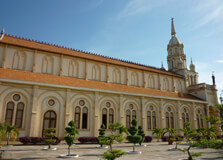
Cu Lao Gieng (Gieng Island) is a hidden cultural gem located in the Mekong River between the provinces of An Giang and Dong Thap. Though technically not in Vinh Long province, it is commonly included in Mekong Delta itineraries from Vinh Long due to its close proximity and cultural significance. Known for its unique religious architecture, peaceful riverside landscapes, and a strong Catholic heritage, Cu Lao Gieng offers a quiet, reflective escape from the hustle of urban life. It remains relatively untouched by mass tourism, preserving its authenticity and spiritual charm. How to Reach Cu Lao Gieng, Vinh Long Although Cu Lao Gieng is an island in the Mekong River, it is accessible with a combination of road and boat travel: From Vinh Long City: Travel by road to Chau Thanh District, Dong Thap Province (around 2.5 to 3 hours). From there, take a ferry or small boat to Cu Lao Gieng Island. By Boat Tour: Several Mekong River boat tours from Vinh Long or My Tho include Cu Lao Gieng in multi-day itineraries. This is a relaxing and scenic way to explore the area. From Long Xuyen City: Visitors often access Cu Lao Gieng from An Giang province. A ferry from Cho Moi town takes you directly to the island. It is recommended to hire a local guide or join a guided tour, as signage and public transport are limited. Weather at Cu Lao Gieng, Vinh Long Cu Lao Gieng experiences a typical Mekong Delta tropical climate, making it accessible and pleasant for most of the year: Dry Season (December to April): Ideal for travel, with sunny days, cool breezes, and minimal rainfall. Temperatures range from 24°C to 32°C. Rainy Season (May to November): The region receives occasional rain, especially in the afternoons. The landscape becomes greener and more vibrant, but be cautious of muddy paths. Morning and late afternoon visits are best for enjoying the mild temperatures and soft lighting for photography. Timing and Entry Details Cu Lao Gieng is not a restricted tourist site, and entry to most places is free. However, some churches or monasteries may have limited hours for public access. Opening Hours: 6:00 AM – 6:00 PM (for most religious buildings) Entry Fee: Free (donations are accepted in churches or for guided tours) There are no official ticket booths. Visitors should be respectful of religious services and local customs, especially in churches and convents. Why Cu Lao Gieng is Famous Cu Lao Gieng is famous for being a spiritual and historical center of Catholicism in the Mekong Delta. It is home to one of the oldest Catholic churches in southern Vietnam, the Cu Lao Gieng Church, which showcases a unique European architectural style amidst a traditional Vietnamese riverside village. The island is also known for its peaceful lifestyle, traditional boat-building villages, and scenic river views. It is considered a pilgrimage site for many Vietnamese Catholics and is visited for its calm ambiance and spiritual legacy. History and Architecture The history of Cu Lao Gieng dates back to the 19th century when Catholic missionaries from France arrived in Vietnam and established religious institutions. The most iconic structure, Cu Lao Gieng Church, was built around 1872, inspired by European Gothic and Romanesque styles. It features arched doorways, bell towers, and stained glass windows. The island also houses several other religious buildings, including: The Franciscan Convent: A peaceful and architecturally rich nunnery with gardens and chapels. The Seminary of Cu Lao Gieng: Once a major center for training priests and religious scholars in southern Vietnam. Wooden boat workshops: Traditional boat-building techniques have been passed down through generations here. The blend of European religious architecture with the surrounding Vietnamese countryside creates a unique and serene cultural experience. Things to Do at Cu Lao Gieng, Vinh Long Visitors can enjoy a mix of cultural exploration, religious sightseeing, and interaction with local villagers: Visit Cu Lao Gieng Church: Admire the grand design, take photographs, and attend a local mass if possible. Explore the Franciscan Convent: Walk through peaceful gardens and learn about the lives of the nuns who reside there. Tour Boat-Building Villages: Observe how traditional wooden boats are handcrafted by local artisans. Bike around the island: Rent a bicycle and explore narrow village lanes surrounded by coconut trees and rice paddies. Interact with Locals: Enjoy friendly conversations, homemade snacks, and insights into the island's customs. Interesting Facts about Cu Lao Gieng The Cu Lao Gieng Church was modeled after French cathedrals and is one of the oldest of its kind in Vietnam. The island is about 6 kilometers long and 3 kilometers wide, surrounded by the Mekong River. Traditional boat building is still practiced using age-old methods and is an important livelihood on the island. The island remains off the beaten path, making it perfect for travelers seeking a quiet, non-commercialized experience. Cu Lao Gieng played a role in religious education and missionary work during the French colonial era. Tips for Visiting Cu Lao Gieng, Vinh Long Dress modestly, especially when visiting churches or religious compounds. Wear comfortable shoes suitable for walking or cycling along unpaved paths. Bring bottled water, snacks, and cash, as shops and services are limited on the island. Consider hiring a local guide who can provide historical context and help navigate the area. Photography is allowed in most areas, but ask permission before photographing religious ceremonies or local residents. Visit early in the morning or late in the afternoon to avoid heat and enjoy golden-hour lighting for photos. Respect the peaceful environment—avoid loud behavior or disrupting religious services.
Explore More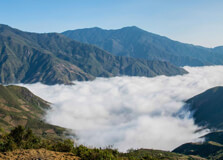
Ta Xua Mountain, located in Bac Yen District on the border of Yen Bai and Son La provinces in northern Vietnam, is one of the most famous destinations for cloud hunting and adventure tourism. This majestic mountain range is part of the Hoang Lien Son range and features rugged peaks, dramatic valleys, and a climate perfect for witnessing seas of clouds, especially during the early morning hours. Rising over 2,865 meters above sea level, Ta Xua is the tenth highest mountain in Vietnam and has gained popularity among hikers, trekkers, and photographers. The area is also home to ethnic minority groups, especially the H'mong, who have preserved their traditional lifestyles and customs for generations. Ta Xua is not just a destination—it’s an experience of raw nature, cultural richness, and physical challenge. How to Reach Ta Xua Mountain, Yen Bai Though located in a remote region, Ta Xua can be accessed fairly easily from Hanoi or Yen Bai City with some planning: From Hanoi: Travel around 200 km to Bac Yen District (Son La Province), then continue 15 km uphill to Ta Xua Commune. The trip takes 6–7 hours by car or motorbike. From Yen Bai City: Drive south toward Bac Yen, via Nghia Lo, which takes approximately 4 hours. The route includes mountain passes, so driving skill is essential. By Motorbike: This is the most popular method among adventurers. Renting a motorbike allows flexibility to explore nearby mountain ridges and villages. By Bus: Take a sleeper or minibus from Hanoi to Bac Yen Town. From there, hire a local motorbike taxi or rent a bike to reach the mountain. Weather at Ta Xua Mountain, Yen Bai Ta Xua has a cool mountain climate year-round, with significant variations in temperature and visibility depending on the season: Cloud-Hunting Season (December – March): Best time to visit. Cold mornings (6°C to 15°C) produce stunning cloud formations. Spring (March – May): Clear skies, flower blossoms, and comfortable temperatures (15°C to 25°C). Good for trekking. Summer (June – August): Hot and rainy, with slippery trails and reduced visibility. Not ideal for hiking or cloud viewing. Autumn (September – November): Mild and dry weather, beautiful golden rice terraces in nearby valleys. Ideal for hiking and photography. Timing and Entry Details There are no formal gates or entry fees for Ta Xua Mountain, but visitors should be aware of logistics: Access Time: 24/7, but best to explore from 5:00 AM to 5:00 PM for safety and visibility. Entry Fee: No official ticket required, though parking or guided tours may charge small fees (30,000–100,000 VND). Local Guides: Available for hire in Ta Xua village. Highly recommended for overnight treks or exploring hidden trails. Best Months to Visit: December to March (for clouds), and September to November (for dry, clear hiking weather). Why Ta Xua Mountain is Famous Ta Xua is best known for its incredible “cloud sea” that rolls over the valleys in the early morning. The mountain’s position and altitude create perfect conditions for cloud formations, making it one of Vietnam’s most iconic cloud-hunting spots. Other reasons for its popularity include: Dinosaur Spine Ridge: A narrow, dramatic mountain ridge resembling the back of a dinosaur—a famous Instagram-worthy trekking path. Panoramic Views: Breathtaking vistas from the top, especially during sunrise and sunset. Ethnic Culture: Experience the life of the H'mong people, including their traditional homes, clothing, and cuisine. History and Cultural Significance While Ta Xua does not have extensive recorded history, it holds cultural and spiritual importance for local ethnic groups. The H’mong people consider the mountain sacred and part of their ancestral land. The area has also remained relatively untouched by modern development, helping preserve its natural beauty and cultural authenticity. Visitors can still find remnants of H’mong culture in: Traditional Stilt Houses: Built using local wood and stone. Shamanic Practices: Some villages still practice animism and conduct rituals tied to nature and mountain spirits. Things to Do at Ta Xua Mountain Cloud Hunting: Wake up early to witness the “ocean of clouds” at sunrise—best seen from high ridges like the Dinosaur Spine. Trekking: Hike to high viewpoints, including Phu Sa Phin peak. Trails range from moderate to challenging. Motorbike Adventure: Ride through winding mountain roads and enjoy panoramic landscapes. Camping: Spend the night under the stars on mountain peaks for a once-in-a-lifetime experience. Local Experiences: Join the H’mong people for a meal, try their herbal teas, or learn about their textile weaving. Interesting Facts about Ta Xua Mountain Ta Xua is the 10th highest peak in Vietnam and part of the Hoang Lien Son range. The Dinosaur Spine ridge is only a few feet wide and offers thrilling 360° views. The sea of clouds occurs most often at altitudes of 2,000–2,400 meters. Ta Xua is less commercial than Sa Pa or Fansipan, offering a more authentic adventure experience. It is one of the top paragliding spots in Vietnam during festivals. Tips for Visiting Ta Xua Mountain, Yen Bai Arrive Early: For cloud hunting, aim to be at the top by 5:30–6:00 AM. Bring Warm Clothing: Even in warmer seasons, mornings and evenings are cold at high altitudes. Use a Good Camera: The landscape is stunning—photographers will want quality gear for sunrise, cloud formations, and starry skies. Travel with a Guide: Trails can be confusing; local guides ensure safety and deeper insights. Prepare for Basic Conditions: Accommodations in the area are mainly homestays or guesthouses with basic facilities. Bring Food and Water: Supplies are limited on the trails, so pack adequately. Respect Local Customs: Dress modestly and ask before taking photos of locals or entering homes.
Explore More